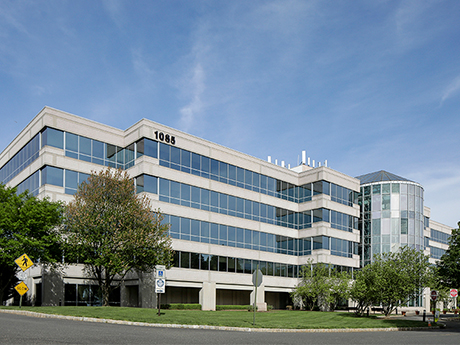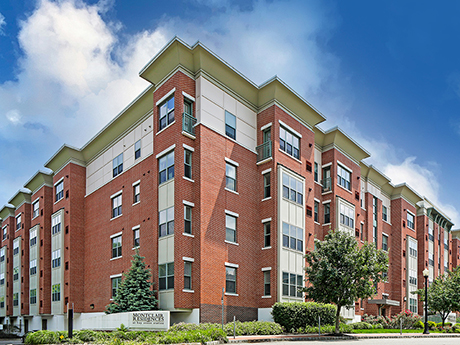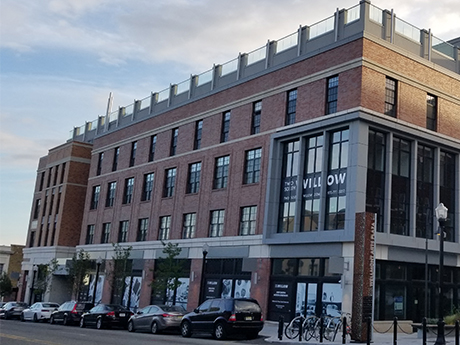By Ken Colao, president and CEO, CNY Group Whether you’re on the Jersey Parkway or the Turnpike, you’ve undoubtedly driven past commercial buildings and office parks that have stood in the Garden State for decades. But the age of many of these structures is starting to cause problems. Earlier this year, JLL released a report in which the real estate firm estimated that 57 percent of suburban office space nationwide is old enough to be considered functionally obsolete. In New Jersey, specifically, that figure rises to 72 percent, among the highest in the nation. Based on two decades worth of construction experience in New Jersey and New York, CNY Group believes the two most likely outcomes for these structures involve upgrades to true Class A offices or conversion to life sciences facilities. Keeping Offices Intact With a growing number of people migrating out of urban cores, suburban office developers are revitalizing their properties to attract new tenants. When employees began moving away from city centers, employers didn’t particularly follow them, but that trend could change. Businesses will decrease their real estate footprints in urban areas unless costs of occupancy are reduced, safety is maintained and environmental standards and practices are …
New Jersey
By Mike Oliver, managing director, JLL Capital Markets Fundamentals remain strong within the multifamily markets of Northern New Jersey and the greater metro New York City area, though the dynamics have continued to shift since the onset of the pandemic. During COVID-19, there was movement away from urban areas toward the suburbs, creating a “tale of two cities” market dynamic. The suburban multifamily market became red-hot while urban markets cooled. Vacancies dipped below 80 percent in some instances, with heavy concessions being offered and flat to negative gross rent growth. Today, while the suburban markets remain very strong, urban markets are also now red-hot. This is attributable to more and more people heading back to urban centers in anticipation of returning to the office or simply wanting to be back in the excitement of downtown living and its dining, shopping and entertainment options. Additionally, many renters are being priced out of and fleeing Manhattan, Brooklyn and other New York City neighborhoods. Jersey City and the Hudson Waterfront provide attractive rental options with incredible access into Manhattan. Jersey City, for example, is demonstrating healthy fundamentals, as occupancy rates are back over 95 percent with strong growth on lease trade-outs. There …
By Brian Katz (CEO), Amy Staats (vice president), Jonathan Greenberg (director), Adam Caplan (director) and Hugh Scullin (vice president) of Katz & Associates The Northern New Jersey retail real estate market has been flourishing in the post-COVID-19 era. Inventory continues to shrink across the board, with exceptional demand for drive-thru locations and mid-size boxes. Furthermore, the modern, well-anchored neighborhood and power centers seldom have more than one or two small shop vacancies. Some categories in high demand include discount apparel, grocery, food, health and beauty, fitness and medical. Northern New Jersey specifically benefits from its critical mass and its ease of access to main roads and points of entry. Tenants that have been able to refocus and adapt have thrived in a market that already has a lot going for it. Simply put, the post-COVID bounce has been better than we could have imagined, and from a company standpoint, the pipeline of deals that are in the works or have closed has been among the strongest in our history. Leasing Activity Leasing activity is up. Market adjustments aside, leasing activity has pretty much returned to pre-pandemic levels. In some instances, it’s even easier to get deals across the finish line …
By Taylor Williams Industrial brokers and developers throughout New Jersey and Eastern Pennsylvania are flush with tenant demand, but the frenetic pace and frequency at which revenues and costs change in this market has introduced a whole new set of operating challenges. In terms of the supply side of the market, developers of industrial product, like those of every other property type, have been squeezed by supply chain disruption. Prices and lead times for ordering key materials change radically and often without warning. Developers who try to circumvent these obstacles by ordering way earlier than normal in the process now run an increased risk of having to take delivery of supplies without having all permits and sources of construction financing in place. Such a misfire in timing can create lags in delivery, potentially alienating tenants needing turnkey space and generating additional short-term costs via storage of the materials before construction begins. In addition, misaligning these timelines can spook potential investors that want the certainty of knowing that a project is moving forward. “We’re buying supplies a year in advance and trying to sync up deliveries of those materials with when we expect to have full project approval,” says Peter Polt, …
By Taylor Williams Northern New Jersey is teeming with new multifamily projects, many of them transit-oriented, that mesh suburban locations with urban lifestyles, making the region a desirable alternative to living in New York City. But more housing product is unquestionably needed. According to the U.S. Census Bureau, the Garden State’s population grew by 5.7 percent from approximately 8.8 million to 9.3 million in 2020. New Jersey is the 11th-most populous state and the fifth-smallest state by area, and thus has the highest level of population density in the country. The combination of a growing population and a very limited supply of land means that infill development sites that provide direct access to major cities, most notably New York City and Philadelphia, are highly coveted by developers of all property types. But developers that can deliver the right kind of housing on those sites play central roles in helping municipal leaders bring new jobs, retailers and restaurants to their communities. CENTURION Union Center, a mixed-use project which includes nearly 300 new homes and approximately 27,000 square feet of retail space, is just one such project that ties together a basic need for housing with a larger revitalization of the community. …
By Taylor Williams Demand for retail and restaurant space in Northern New Jersey has long been buoyed by spillover tenants that find themselves priced out of premium spaces in New York City. Yet despite the fact that retail rents throughout the city have been depressed for the last 18 months, users have not flocked to Manhattan and Brooklyn at the expense of the fringe markets of Northern New Jersey. In fact, brokers in the latter region see a healthy level of demand from a wide range of users that see opportunity in the current conditions. “The closures of national soft goods retailers that were squeezed by reduced demand and supply chain constraints during the height of COVID-19 left some beautifully built-out spaces,” notes Kevin Pelio, director of leasing at Azarian Group. “This has benefitted local and regional operators who can come into a prominent retail location without the capital-intensive, upfront investment typically required in a normal market.” Pelio adds that the larger trend among brick-and-mortar retailers to reduce initial capital outlays and build-out costs has also led to reductions in landlords’ tenant improvement (TI) allowances. Brian Katz, CEO of Englewood, N.J.-based Katz & Associates, concurs that certain retailers are aggressively …
By Mark Meisner, president and founder, The Birch Group For many years, corporations have been rethinking their office space utilization, both in terms of square footage per employee and various configurations that allow employees to collaborate and thrive within office settings. As we look ahead to the return to the office, we are already hearing that corporate culture, the sharing of ideas and training of new hires have become driving forces in getting people back into the workplace. At the same time, an increasing number of companies are also considering the hub-and-spoke model as part of their overarching corporate strategic planning. The openings of these satellite offices allow companies to tap into larger talent pools, reduce employee commute times and in some cases, avoid mass transit altogether. Over the past several years, we’ve seen companies like Ross Dress for Less take space on both sides of “The River,” opening offices on Long Island and in The Meadowlands to supplement its New York City headquarters. Now more than ever, with the suburban office market showing signs of a resurgence, there is an onus to go back to the basics and leverage a tenant-focused approach to bolster leasing and differentiate properties. At …
By Taylor Williams Demand for industrial space continues to surge throughout New Jersey and eastern Pennsylvania, prompting developers to undertake more projects on a speculative basis and avail themselves to the classic mantra of “If you build it, they will come.” E-commerce users, spanning every industry from building materials to electronics to food, continue to spearhead the demand side of the equation. According to the U.S. Census Bureau, in 2020, a year in which a global health crisis spurred furious increases in online shopping, e-commerce sales accounted for 14.4 percent of all retail sales, up from 7.3 percent in 2015. That figure is expected to grow to nearly 20 percent by 2024. Lenders are eager to finance speculative industrial projects, and developers are scouring the Mid-Atlantic for viable sites as spec projects increasingly account for bigger portions of their portfolios. “Pre-COVID, and even dating back several years, you might see 20 percent of the Mid-Atlantic industrial projects being done as build-to-suits,” says Rob Borny, senior vice president of capital deployment and head of the East Region for Nevada-based Dermody Properties. “It’s now moving toward being significantly less [build-to-suit activity] due to robust tenant demand, as well as the shorter lead …
By Alex Kachris, research manager — Northeast industrial region, JLL Industrial commercial real estate had its second-best year on record in 2020, with U.S. transaction volume nearing $96 billion. As competition among investors for industrial product remains strong in 2021, JLL Capital Markets Research isolated one sub-class that is gaining investor interest: multi-use logistics. The multi-use logistics profile includes older, multi-tenant assets ranging from 20,000 to 100,000 square feet that have solid footprints within infill urban logistics markets. These assets, which often have diversified, local tenant bases, usually house a mix of distribution, flex showroom, industrial showroom, R&D, warehouse and/or manufacturing space. Multi-use logistics assets boast compelling rent growth profiles and strong long-term outlooks. With new, yield-focused investors jumping into the industrial space, multi-use logistics product is desirable as an alternative to the bulk industrial market, which is getting tighter. Given that multi-use logistics facilities are generally older properties, population centers have exploded around these assets, making not only almost impossible to replace but highly sought-after as last-mile logistics locations close to end users. Compounded by industry fundamentals that are driven by macroeconomic factors, including reshoring and acceleration of e-commerce adoption, the increased demand for these smaller, multi-tenant industrial assets …
By Ken Uranowitz, president, Gebroe-Hammer Associates When it comes to investment in multifamily properties, as in life, change is constant. Between evolving tenant demographics and political climates to recessionary economies and a once-in-a-century pandemic, multifamily assets are continuing to prove their centuries-old knack for pivoting in times of change. Unlike any other commercial asset class, multifamily possesses an unrivaled level of agility rooted in its most-important attribute: People always need a safe place to call home. In good times and turbulent periods, apartment living offers a tremendous level of flexibility based on point-in-time needs. While past recessionary times may have had red-flag indicators of things to come, nothing prepared us for the rippling effects of COVID-19. This virus tested us in ways never seen before. Collectively, we found ourselves in uncharted waters due to the sudden and abrupt measures imposed to slow the spread of COVID-19. While these challenges are being addressed, with the passage of time, health and wellbeing remain paramount. In this regard, multifamily properties have played an integral role in providing tenants and communities with the most basic needs of shelter, a place to live and a place from which to telecommute for work or education. A …
Newer Posts











